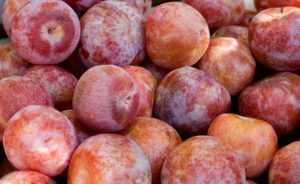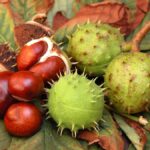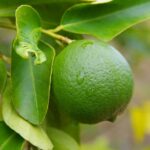You only need to list a few of the varietal names of pluots—’Flavor King’, ‘Flavor Queen’, ‘Flavor Prince’, ‘Flavor Supreme’, ‘Flavor Heart’, ‘Flavorosa’, ‘Flavorella’, ‘Flavor Grenade’—to understand the most outstanding attribute of these hybrids between plums and apricots.
Pluots have the same smooth skin as plums but are generally larger. Like plums, their skins and flesh vary from red to purple to dappled to yellow to emerald green. In fact, an exceptionally tasty-sweet variety is named ‘Emerald Queen’. From sweet to sweet-tart, you certainly will find a variety that suits your taste.
A pluot—which is ¾ plum and ¼ apricot—is all about flavor. It has the flavorful blend of its parents and a higher concentration of sugar.
8 Delicious ways to serve pluots
1. Grilled Pluot Salad
Ingredients:
- 4 ripe pluots, halved and pitted
- 4 cups arugula or mixed greens
- 1/3 cup goat cheese, crumbled
- 1/4 cup toasted walnuts or pecans
- Balsamic glaze or vinaigrette
- Olive oil for grilling
- Salt and pepper to taste
Instructions:
- Preheat a grill or grill pan over medium heat. Lightly brush the cut sides of the pluots with olive oil.
- Grill the pluots cut-side down for about 2-3 minutes or until they have grill marks and are slightly softened.
- Remove from the grill and let cool slightly. Slice each grilled half into wedges.
- Arrange the arugula or mixed greens on a serving platter, top with the grilled pluot wedges, goat cheese, and walnuts.
- Drizzle with balsamic glaze or vinaigrette, and season with salt and pepper. Serve immediately.
2. Pluot Tart
Ingredients:
- 1 sheet of puff pastry, thawed
- 4-5 ripe pluots, thinly sliced
- 2 tbsp sugar
- 1/2 tsp cinnamon
- 1 egg, beaten (for egg wash)
- Optional: powdered sugar for dusting
Instructions:
- Preheat the oven to 400°F (200°C). Line a baking sheet with parchment paper.
- Roll out the puff pastry on the parchment and arrange the pluot slices in overlapping rows or a fan pattern, leaving a 1-inch border.
- Mix the sugar and cinnamon together and sprinkle over the pluot slices.
- Fold the border over the edges of the pluots and brush with the beaten egg.
- Bake for 20-25 minutes or until the pastry is golden brown and the pluots are tender.
- Let cool for a few minutes before serving. Dust with powdered sugar if desired.
3. Pluot Chutney
Ingredients:
- 4-5 ripe pluots, pitted and chopped
- 1 small onion, finely chopped
- 1 tbsp fresh ginger, minced
- 1/3 cup apple cider vinegar
- 1/2 cup brown sugar
- 1/4 tsp red chili flakes (adjust for heat preference)
- 1/2 tsp ground cinnamon
- Pinch of salt
Instructions:
- Combine all ingredients in a saucepan over medium heat.
- Bring to a simmer and cook for about 25-30 minutes, stirring occasionally, until the mixture thickens.
- Remove from heat and let cool. Store in an airtight container in the fridge for up to 2 weeks.
- Serve with roasted meats, on cheese platters, or as a spread on sandwiches.
4. Pluot Smoothie
Ingredients:
- 3-4 ripe pluots, pitted and quartered
- 1 banana
- 1/2 cup Greek yogurt
- 1/2 cup orange juice (or preferred juice)
- 1 tbsp honey (optional)
- Ice cubes (optional, for a thicker smoothie)
Instructions:
- Place all ingredients in a blender and blend until smooth.
- Taste and adjust sweetness with more honey if needed.
- Pour into glasses and serve immediately.
5. Pluot and Prosciutto Appetizers
Ingredients:
- 4-5 ripe pluots, pitted and sliced into thin wedges
- 6-8 slices of prosciutto, cut in half lengthwise
- Fresh basil leaves (optional)
- Toothpicks
Instructions:
- Wrap a slice of prosciutto around each pluot wedge, optionally adding a basil leaf for extra flavor.
- Secure each with a toothpick.
- Arrange on a platter and serve as a quick, elegant appetizer.
6. Pluot Sorbet
Ingredients:
- 5-6 ripe pluots, pitted and chopped
- 1/2 cup sugar (adjust based on sweetness preference)
- 2 tbsp lemon juice
- 1/2 cup water
Instructions:
- Place chopped pluots, sugar, lemon juice, and water in a blender and blend until smooth.
- Strain the puree through a sieve to remove any skin or pulp.
- Pour the mixture into an ice cream maker and churn according to manufacturer instructions.
- Transfer to a container and freeze for at least 2 hours before serving.
7. Pluot Jam
Ingredients:
- 4 cups pluots, pitted and chopped
- 2 cups sugar
- 2 tbsp lemon juice
- 1/2 tsp vanilla extract (optional)
Instructions:
- In a large saucepan, combine chopped pluots, sugar, and lemon juice.
- Bring to a boil over medium-high heat, then reduce to a simmer and cook for 20-25 minutes, stirring occasionally, until thickened.
- Remove from heat and stir in vanilla extract if using.
- Pour into sterilized jars and let cool before sealing. Store in the fridge or process in a water bath for longer storage.
8. Pluot Salsa
Ingredients:
- 4 ripe pluots, finely diced
- 1/2 red onion, finely chopped
- 1/4 cup cilantro, chopped
- 1 jalapeño, seeded and finely chopped
- Juice of 1 lime
- Salt to taste
Instructions:
- Combine all ingredients in a bowl and mix well.
- Let the salsa sit for 10-15 minutes to allow the flavors to meld.
- Serve with tortilla chips, grilled fish, chicken, or as a taco topping.
Enjoy experimenting with these delicious ways to savor pluots!
More ways to serve pluots
Pluots can be eaten fresh out of hand as a snack or dessert. They also can be stewed or used in jellies, jams, sauces, puddings, crisps, cobblers, cakes, and tarts. Pluots can be poached or baked like pears and peaches. Some plums can be dried and served as prunes.
Pluots can be eaten fresh out of hand or cooked.
- Serve quartered or sliced in cream or milk.
- Slice and add raw to fruit salads.
- Fill cavities with soft cheese such as Brie.
- Use firm-ripe plums in poultry or fish salads.
- Use in fruit compotes, tarts, crisps, and cobblers.
- Stew for chutney preserves.
- Use in jams or jellies.
- Use in pies, cakes, puddings, muffins, and ice cream.
- Pluots can replace cherries in most desserts.

How to choose pluots
Like plums, look for pluots that are plump, well-colored, and firm to the touch. Avoid pluots that are too soft or too hard.
How to ripen pluots
Pluots will ripen at room temperature. When a pluot has ripened its skin will lose its shine. Then it can be refrigerated for up to 5 days.
But the best pluot eating comes when the fruit yields slightly to gentle pressure. That’s how you should pick a pluot at the farm market. Then take it home, wash it gently, slice it in half around the pit, rotate the halves to separate, pop out the pit, and pop the fruit in your mouth.
Pluot harvest
Pluots, like plums, come to harvest from early summer through the first weeks of late summer.
Two flavorful pluots
You might compare the flavor of a pluot to a blend of fruit juices. That’s why you will often hear the pluot described as intensely sweet and fruity.
That’s not too surprising given that the pluot’s parents are the plum and the apricot. Because the pluot is ¾ plum, it is no surprise that it has a plum-like shape, skin, and flesh. The pluot also has the plum’s texture and rich, juicy sweetness.
Five friends tasted five different pluot varieties available at the farm market this week. The pluots they tasted were: ‘Emerald Beauty’, ‘Flavor Treat’, ‘Flavor Grenade’, ‘Dapple Dandy’, and ‘Black Cat’.
They rated two varieties well ahead of the others. They were partial to ‘Flavor Grenade’ and ‘Emerald Beauty’, with ‘Flavor Grenade’ being the favorite of four of the five tasters.
Here’s how ‘Flavor Grenade’ and ‘Emerald Beauty’ compared:
Emerald Beauty has deep rich yellow to emerald green skin and is conical like an apricot, though larger. Eaten out of hand, its flesh is amber and plum-like near the surface but descends to an apricot-like pit that separates from the flesh just like an apricot. While the initial taste is sweet and plum-like, the aftertaste is remarkably apricot. The flesh immediately around the pit has almost the exact texture and taste of an apricot.
Flavor Grenade has the more traditionally rounded shape of a large plum and its coloring is similar to a light-skinned plum with streaks and speckles of amber and red. Eaten out of hand its flesh is amber to the pit with a plum-like texture and juiciness to the last bite.
While the flavor of the Emerald Beauty is reminiscent of the apricot, the Flavor Grenade is simply an explosion of sweet fruit juices: the rich sweetness of a ripe plum and the drippy sugary taste of a very ripe apricot. “Wow!” is how one of our tasters described it.
About pluots
Pluots are the late 20th-century creation of a California farmer named Floyd Zaiger. Zaiger’s work with pluots–and another apricot-plum hybrid called an aprium–has been built on the foundation of another California fruit breeder, Luther Burbank. One hundred years ago, Burbank, who was the horticultural equivalent of Thomas Edison, introduced more than 100 varieties of plums—including the taste standard the Santa Rosa plum– and his own plum-apricot hybrid called the plumcot.
The pluot is a hybrid between different Prunus species, also called interspecific plums.
Related articles:
Planning the Home Fruit Garden
Garden Planning Books at Amazon:
- Vegetable Garden Almanac & Planner
- Kitchen Garden Grower’s Guide Vegetable Encyclopedia
- Vegetable Garden Grower’s Guide
- Tomato Grower’s Answer Book
More kitchen tips:
Bring your harvest to the table. Kitchen prep tips and easy recipes for the vegetables you grow. Click below for vegetable prep and recipes you can use now.
- Almonds
- Apples
- Apricot
- Aprium
- Artichoke
- Arugula
- Asparagus
- Avocado
- Bamboo Shoots
- Banana
- Basil
- Beans, Dried
- Beans. Long
- Beans, Shell
- Beans, Snap
- Beets
- Bitter Melon
- Blackberry
- Bok Choy
- Broccoli
- Broccoli Raab
- Brussels Sprouts
- Cabbage
- Cardoon
- Carrots
- Cauliflower
- Celeriac
- Celery
- Chard
- Chayote Squash
- Cherimoya
- Cherries
- Chestnut
- Chickpea
- Chinese Cabbage
- Chives
- Cilantro
- Citron
- Clementine
- Collards
- Coriander
- Corn, Sweet
- Corn, Baby
- Corn Salad, Mache
- Cranberry
- Cress
- Cucumber
- Daikon
- Dandelion
- Dill
- Eggplant
- Endive, Belgian
- Endive and Escarole
- Fava Beans
- Fig
- Florence Fennel
- Garlic
- Ginger
- Grapefruit
- Grapes
- Guava
- Horseradish
- Jerusalem Artichoke
- Jicama
- Jujube
- Kale
- Kiwifruit
- Kohlrabi
- Kumquat
- Leeks
- Lemongrass
- Lemons
- Lettuce
- Lime
- Mache (Corn Salad)
- Mandarin Orange
- Mango
- Maple Syrup
- Marjoram
- Melons
- Michihili
- Mint
- Mizuna
- Mushrooms
- Mushrooms, Cremini
- Mustard Greens
- Napa Cabbage
- Nectarine
- Okra
- Olives
- Olive oil
- Onions
- Oranges
- Oregano
- Parsley
- Parsley Root
- Parsnips
- Passion Fruit
- Pawpaw
- Peaches
- Pears
- Peas, Garden Snap
- Peas, Snow
- Pei Tsai
- Peppers, Chili
- Peppers, Sweet
- Persimmon
- Pineapple
- Pineapple Guava
- Plantain
- Plums
- Pluots
- Pomegranate
- Potatoes
- Prickly Pear
- Pumpkin
- Quince
- Radicchio
- Radishes
- Raspberries
- Rosemary
- Rhubarb
- Rutabaga
- Sage
- Salsify
- Sauerkraut
- Savory
- Shallots
- Sorrel
- Spinach
- Squash, Summer
- Squash, Winter
- Strawberries
- Sunchokes
- Sunflower
- Sweet Potato
- Swiss Chard
- Tangerine
- Taro
- Tarragon
- Thyme
- Tomatillo
- Tomato
- Turnip
- Turnip Greens
- Yams















